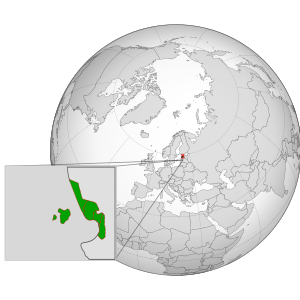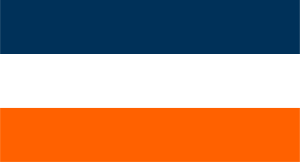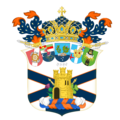Independent Duchy of Kårlsberg
Independent Duchy of Kårlsberg | |
|---|---|
| Motto: For Duke and People | |
Anthem: Stolz de Herzohg
lyrics english translation: In this land most dear we gained our freedom, Generation upon generation blessed to be born here, Here our sea sighs, here our cities ring out, here Aalbæk resounds. Let Kårlsberg live forever, Let it shine bright in the Duke's crown! On Duke's road to blessings and glory, With the flag of October we will go on forever. We will guard our Kårlsberger Fatherland, Everyone to the last drop of our blood. 𝄆Let Kårlsberg live forever, Let it shine bright in the Duke's crown!𝄇[2] | |
 | |
| Capital | (One of the smallest cities) Aalbæk  Crest of Aalbæk |
| Official languages | Kårlsbergian German, Latvian |
| Demonym(s) | Kårlsbergian, Kårion |
| Government | Unitary parliamentary constitutional monarchy |
• Sovereign | Vivaldis (the 2.) Blekte, Duke of Kårlsberg |
• Prime Minister | Voldemars Peters Melderis of Kårlsberg |
| Legislature | Parliament |
| Establishment | 17.february.1776 |
| Population | |
• Census | 17 |
| Currency | Kårlsbergian Mark, Euro (de facto) |
| Time zone | UTC-5:00 (standard time) UTC-4:00 (summer time) |
This article refers to a micronation or element of micronationalism which is defunct and no longer exists. You can help make the article reflect that or ask on the talk page for further information. |
Today's Kårlsberg
The Duchy of Kårlsberg is a democratic duchy located in the Baltic Sea, which since the dissolution in 1790 was only resumed by people in 2022. The traditions, anthem, flag, coat of arms, title have been kept, even if the lands have shrunk, so the duchy belongs only to micronations instead of own states. As for the human heritage of the Duchy, it has nothing to do with the present Independent Duchy. Therefore, the word "Independent" in the title refers to 1. independence from Latvia 2. from the former Kårlsberg family.
Division of the provinces and urban districts
Like many other countries, the Duchy contains federal lands, which also contain urban regions. Since the Duchy of Kårlsberg is relatively small in 2022, it nevertheless has a "mainland area" and an "island area" and in these areas again the city regions. The interesting thing about these areas is that none of them is really mainland, since the Duchy of Kårlsberg is located on an island, and own a small part of the coast of this island and a small island. As in other countries, the capital is an extra area that does not belong to either of the other two areas. So in summary, the island has 3 regions:
| Name of the Regions | approx. Size | Coat of arms | Role | Number of city regions |
|---|---|---|---|---|
| Aalbæk | 1000 m² | Crest of Aalbæk |
Capital | 1 |
| Ūdeņu | 8.300 m² |  Crest of Ūdeņu |
Island Region | 4 |
| Cietā | 32.514 m² |  Crest of Cietā |
Coast Region | 4 |
National symbols and flags
Like most nations, the Duchy of Kårlsberg has its very own coats of arms, flags symbolism and etc. The national animal here is, for example, the double-headed lion, which, among other things, is also recorded on the passport. The symbols are also recorded in the coat of arms and it was also referred to these. The double-headed lion, for example, became the symbol of the Principality, as it reflected the thoughts of the 1st Duke (Stefanuk Ìvan 1.). For example, it was said that the 1st Duke changed his personality and always alternated between two. This was never documented, but was told only by word-of-mouth, but it was still included in the lion, which, as I said, is supposed to characterize the character of the 1st Duke.






